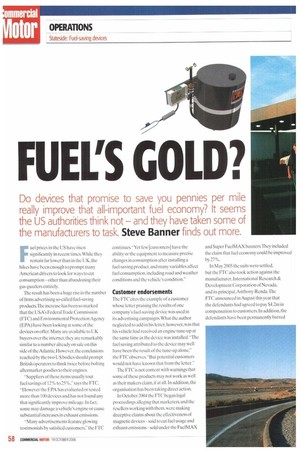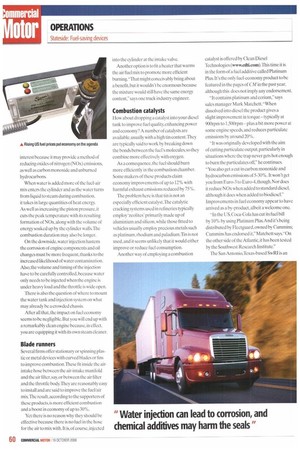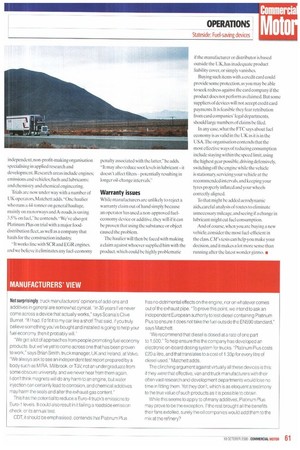FUEL'S GOLD?
Page 58

Page 59

Page 60

Page 61

If you've noticed an error in this article please click here to report it so we can fix it.
Do devices that promise to save you pennies per mile really improve that all-important fuel economy? It seems the US authorities think not — and they have taken some of
the manufacturers to task. Steve Banner finds out more. prices in the US have risen significantly in recent times. While they remain far lower than in the UK, the
hikes have been enough to prompt many American drivers to look for ways to cut consumption —other than abandoning their gas-guzzlers entirely.
The result has been a huge rise in the number of firms advertising so-called fuel-saving products:Me increase has been so marked that the USA's Federal Trade Commission (FTC) and Environmental Protection Agency (EPA) have been looking at some of the devices on offer. Many are available to UK buyers over the internet; they are remarkably similar to a number already on sale on this side of the A tlantic.However, the conclusions reached by the two US bodies should prompt British operators to think twice before bolting aftermarket goodies to their engines.
"Suppliers of these items usually tout fuel savings of 12% to 25%," says the FTC. "However the EPA has evaluated or tested more than l 00 devices and has not found any that significantly improve mileage. In fact, some may damage a vehicle's engine or cause substantial increases in exhaust emissions. -Many advertisements feature glowing testimonials by satisfied customers," the FTC
continues, "Yet few [customers] have the ability or the equipment to measure precise changes in consumption after installing a fuel-saving product, and many variables affect fuel consumption, including road and weather conditions and the vehicle's condition."
Customer endorsements
The FTC cites the example of a customer whose letter praising the results of one company's fuel-saving device was used in its advertising campaigns. What the author neglected to add in his letter, however, was that his vehicle had received an engine tune-up at the same time as the device was installed.-The fuel saving attributed to the device may well have been the result of the tune-up alone," the FTC observes. "But potential customers would not have known that from the letter."
The FTC is not content with warnings that some of these products may not work as well as their makers claim, if at all. In addition, the organisation has been taking direct action. In October 2004 the FTC began legal proceedings alleging that marketers, and the resellers working with them, were making deceptive claims about the effectiveness of magnetic devices—said to cut fuel usage and exhaust emissions—sold under the FuelMAX
and Super FuelMAX banners.They included the claim that fuel economy could he improved by 27%. In May 2005 the suits were settled, but the FTC also took action against the manufacturer, International Research & Development Corporation of Nevada. and its principal,Anthony Rendalhe FTC announced in August this year that the defendants had agreed to pay $4.2m in compensation to customers. In addition, the defendants have been permanently barred from producing, marketing and selling
Fuel M AX. Super FuelMAX, or similar items.
The wording of the settlement is damning. -It bars false or unsubstantiated claims and misrepresentations that products increase mileage or reduce emissions," says the Frc. "The settlement bars the defendants from misrepresenting the contents, validity, results, conclusions or interpretations of studies, and bars them from performance or efficacy claims unless they possess and rely upon competent and reliable evidence.
It also bars them from assisting others,or providing others with the means to commit deception," the FTC says.The case was brought with the assistance of the EPA.
Poles apart?
The idea that magnets attached to, or placed in the vicinity of, fuel lines or in the engine's air intake can cut fuel consumption has been around for several years.They are said to align the fuel's molecules and break down long chains into short ones, causing the fuel to burn more rapidly and efficiently. However, the only effect such products are likely to have is to cause the fuel to move very slightly away from the magnet in question.
Molecules vibrate constantly at high speed — and even if a magnet did manage to align them, they would soon un-align themselves once they had flowed past it. Furthermore, breaking down long molecules usually requires heat and pressure, as well as some kind of catalyst.
Nor is it necessarily the case that aligning and shortening molecules would result in better fuel consumption anyway. No independent evidence has been produced by a reputable UK test house to show that magnetbased economy packages have any impact on fuel usage on way or another.
Indeed, there's a slim chance that fitting magnets may damage an engine. "I can't say I've come across any instances of this happening — although,with ECUs mounted on the engine block, this has to be a possibility," says Clive Burnet, sales engineering manager at Scania's UK operation.
Cool running
Water injection as a method of improving combustion has been around for a long time — it was used on some fighter aircraft in World War II to increase power on take-off.
Add water to the incoming fuel-air mix,the argument goes,and you cool the combustion chamber, as well as the mixture. As a result the compression ratio is increased, in effect boosting the octane rating of the fuel.That can improve performance, especially if the engine is fitted with a supercharger or a turbocharger.
The water is sometimes mixed with alcohol which, as well as being combustible, acts as an antifreeze—a benefit particularly welcomed by Luftwaffe pilots on the Russian front. Chrysler and Saab have both made use of water injection in the past.While the charge-cooler in effect a less clumsy means of achieving the same end—has largely superseded it, water injection remains of
interest because it may provide a method of reducing oxides of nitrogen (N0x) emissions, as well as carbon monoxide and unburned hydrocarbons.
When water is added more of the fuel-air mix enters the cylinder and as the water turns from liquid to steam during combustion, it takes in large quantities of heat energy. As well as increasing the piston pressure. it cuts the peak temperature with its resulting formation of NOx, along with the volume of energy soaked up by the cylinder walls.The combustion duration may also be longer.
On the downside, water injection hastens the corrosion of engine components and oil changes must be more frequent, thanks to the increased likelihood of water contamination. Also, the volume and timing of the injection have to be carefully controlled, because water only needs to be injected when the engine is under heavy load and the throttle is wide open.
There is also the question of where to mount the water tank and injection system on what may already he a crowded chassis.
After all that, the impact on fuel economy seems to be negligible. But you will end up with a remarkably clean engine because, in effect. you are equipping it with its own steam cleaner.
Blade runners
Several firms offer stationary or spinning plastic or metal devices with curved blades or fins to improve combustion.These fit inside the airintake hose between the air-intake manifold and the air filter, say, or between the air filter and the throttle body.They are reasonably easy to install and are said to improve the fuel/air mix.The result,according to the supporters of these products, is more efficient combustion and a boost in economy of up to 30%. Yet there is no reason why they should be effective because there is no fuel in the hose for the air to mix with. It is, of course, injected
into the cylinder at the intake valve.
Another option is to fit a heater that warms the air/fuel mix to promote more efficient burning."That might conceivably bring about a benefit,but it wouldn't be enormous because the mixture would still have the same energy content," says one truck industry engineer.
Combustion catalysts
How about dropping a catalyst into your diesel tank to improve fuel quality, enhancing power and economy? A number of catalysts are available, usually with a high tin content.They are typically said to work by breaking down the bonds between the fuel's molecules, so they combine more effectively with oxygen.
As a consequence, the fuel should burn more efficiently in the combustion chamber. Some makers of these products claim economy improvements of up to 12% with harmful exhaust emissions reduced by 75%.
The problem here is that tin is not an especially efficient catalyst.'The catalytic cracking systems used in refineries typically employ `zeolites primarily made up of aluminium and silicon, while those fitted to vehicles usually employ precious metals such as platinum, rhodium and paladium.Tin is not used,and it seems unlikely that it would either improve or reduce fuel consumption. Another way of employing a combustion
catalyst is offered by Clean Diesel Technologies (www.cdfi.com).This time it is in the form of a fuel additive called Platinum Plus. It's the only fuel-economy product to be featured in the pages of CM in the past year, although this does not imply any endorsement.
"It contains platinum and cerium," says sales manager Mark Matchett."When dissolved into diesel the product gives a slight improvement in torque— typically at 900rpm to 1,500rpm — plus a bit more power at sonic engine speeds, and reduces particulate emissions by around 20%.
-It was originally developed with the aim of cutting particulate output. particularly in situations where the trap never gets hot enough to burn the particulates off." he continues -You also get a cut in carbon monoxide and hydrocarbon emissions of 5-30%. It won't get you from Euro-3 to Euro-4, though. Nor does it reduce NOx when added to standard diesel, although it does when added to biodiesel." Improvements in fuel economy appear to have arrived as a by-product, albeit a welcome one.
-In the US, Coca-Cola has cut its fuel bill by 10% by using Platinum Plus. And it's being distributed by Fleetguard.owned by Cummins; Cummins has endorsed it," Matchett says."On the other side of the Atlantic, it has been tested by the Southwest Research Institute." The San Anionio,Texas-based SwRI is an
independent, non-profit-making organisation specialising in applied research and development. Research areas include engines; emissions and vehicles; fuels and lubricants: and chemistry and chemical engineering.
Trials arc now under way with a number of UK operators, Matchett adds. "One haulier who runs a 44-tonner on general haulage, mainly on motorways and A-roads, is saving 3.5% on fuel," he contends."We've also got Platinum Plus on trial with a major fooddistribution fleet,as well as a company that hauls for the construction industry. "It works line with SCR and EGR engines, and we believe it eliminates any fuel-economy
penalty associated with the latter," he adds. "It may also reduce soot levels in lubricant —it doesn't affect filters—potentially resulting in longer oil-change intervals."
Warranty issues
While manufacturers are unlikely to reject a warranty claim out of hand simply because an operator has used a non-approved fueleconomy device or additive, they will if it can be proven that using the substance or object caused the problem. The haulier will then be faced with making a claim against whoever supplied him with the product, which could be highly problematic
if the manufacturer or distributor is based outside the U K, has inadequate product liability cover,or simply vanishes.
Buying such items with a credit card could provide some protection, as you may be able to seek redress against the card company if the product does not perform as claimed. But some suppliers of devices will not accept credit card payments. It is feasible they fear retribution from card companies' legal departments, should large numbers of claims be filed.
In any case, what the FTC says about fuel economy is as valid in the 1:1C as it is in the USA,The organisation contends that the most effective ways of reducing consumption include staying within the speed limit,using the highest gear possible, driving defensively, switching off the engine while the vehicle is stationary servicing your vehicle at the recommended intervals, and keeping your tyres properly inflated and your wheels correctly aligned.
'lb that might be added aerodynamic aids, careful analysis of routes to eliminate unnecessary mileage, and seeing if a change in lubricant might cut fuel consumption.
And of course, when you are buying a new vehicle, consider the most fuel-efficient in the class. CM's tests can help you make your decision, and it makes a lot more sense than running after the latest wonder gizmo.
MANUFACTURERS' VIEW
Not surprisingly, truck manufacturers' opinions of add-ons and additives in general are somewhat cynical. "In 35 years I've never come across a device that actually works," says Seania's Clive Burnet. "If I had, I'd fit it to my car like a shot! That said. if you truly believe something you've bought and installed is going to help your fuel economy, then it probably will."
"We get a lot of approaches from people promoting fuel economy products, but we've yet to come across one that has been proven to work," says Brian Smith, truck manager, UK and Ireland, at Volvo. "We always ask to see an independent test report prepared by a body such as Ml RA, Millbrook, or TOV, not an undergraduate from some obscure university, and we never hear from them again. I don't think magnets will do any harm to an engine, but water injection can certainly lead to corrosion, and chemical additives may harm the seals and alter the exhaust gas content."
This has the potential to reduce a Euro-4 truck's emissions to Euro-1 levels. It could also result in it failing a roadside emission check, or its annual test. CDT, it should be emphasised, contends that Platinum Plus
has no detrimental effects on the engine, nor on whatever comes out of the exhaust pipe. "To prove this point, we intend to ask an independent European authority to test diesel containing Platinum Plus to ensure it does not take the fuel outside the EN590 standard," says Matchett.
"We recommend that diesel is dosed at a rate of one part to 1.500." To help ensure this the company has developed an electronic on-board dosing system for trucks. "Platinum Plus costs E20 a litre, and that translates to a cost of 1.33p for every litre of diesel used," Matchett adds.
The clinching argument against virtually all these devices is this: if they were that effective, van and truck manufacturers with their often vast research and development departments would lose no time in fitting them. Yet they don't, which is as eloquent a testimony to the true value of such products as it is possible to obtain.
While this seems to apply to of many additives, Platinum Plus may prove to be the exception. If the rest brought all the benefits their fans extolled, surely the oil companies would add them to the mix at the refinery?


























































































































































































